Two years ago, Maria nearly missed a warning sign. She felt tired, but a home reading sent to her clinic flagged a rising trend. Her care team adjusted therapy the same day, and a hospital visit was avoided.
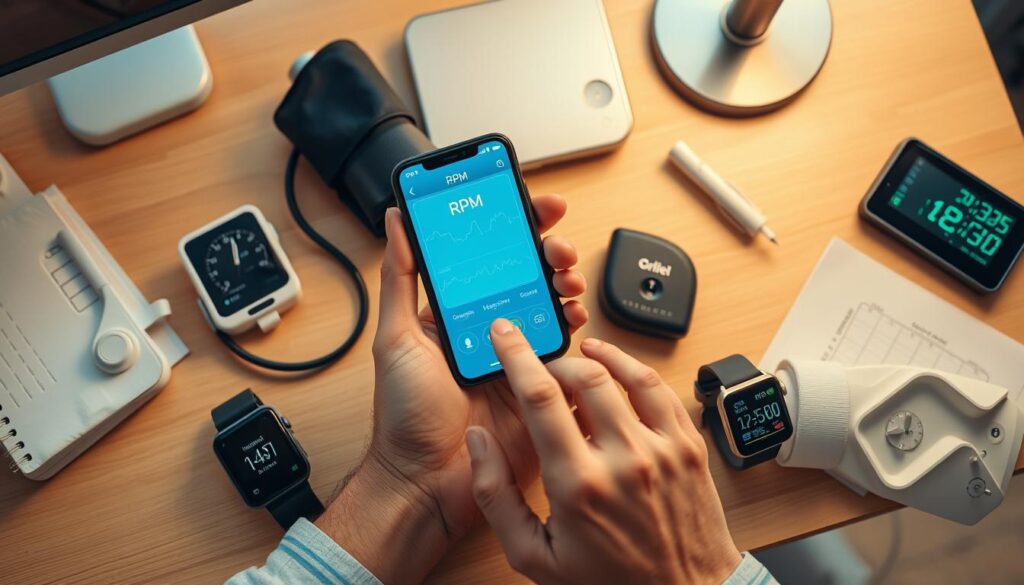
This story shows how remote patient monitoring connects care beyond clinic walls. Continuous patient monitoring gives providers clear trends so they can act early and improve outcomes.
Iottive and other technology partners make this practical. Their Bluetooth, mobile app, and cloud work tie smart tools to secure platforms. With sensor innovation and stronger reimbursement in the United States, adoption is accelerating.
Later sections will review top products, which tools fit specific conditions, and how to integrate secure data flows so monitoring becomes meaningful care.
Key Takeaways
- Remote patient monitoring brings continuous visibility for patients and providers.
- Simple, connected tools at home make care programs more effective.
- Secure, interoperable data flows turn monitoring into timely action.
- Technology partners with BLE, mobile, and cloud expertise enable scale.
- Market growth and reimbursement shifts are making remote care a standard.
Why Remote Patient Monitoring Matters Now for Chronic Conditions
A convergence of policy, market growth, and staffing gaps is pushing connected monitoring into mainstream care.
The U.S. outlook is strong. The market for remote patient monitoring is forecast to jump from $50.39B in 2024 to $203.68B by 2032 at a 19.1% CAGR, with North America holding roughly 48% of share. CMS and state Medicaid moves—plus telehealth flexibility after the pandemic—signal payer support that helps programs scale.
Staff shortages and readmission pressure drive real change. Hospitals and plans use continuous patient monitoring of metrics like blood pressure and weight to spot decline earlier and avoid extra visits or a return to the hospital.
Operational wins come from standardized data flows and smart alerting. Systems that route tasks to the right care teams member cut manual work and protect clinician time.
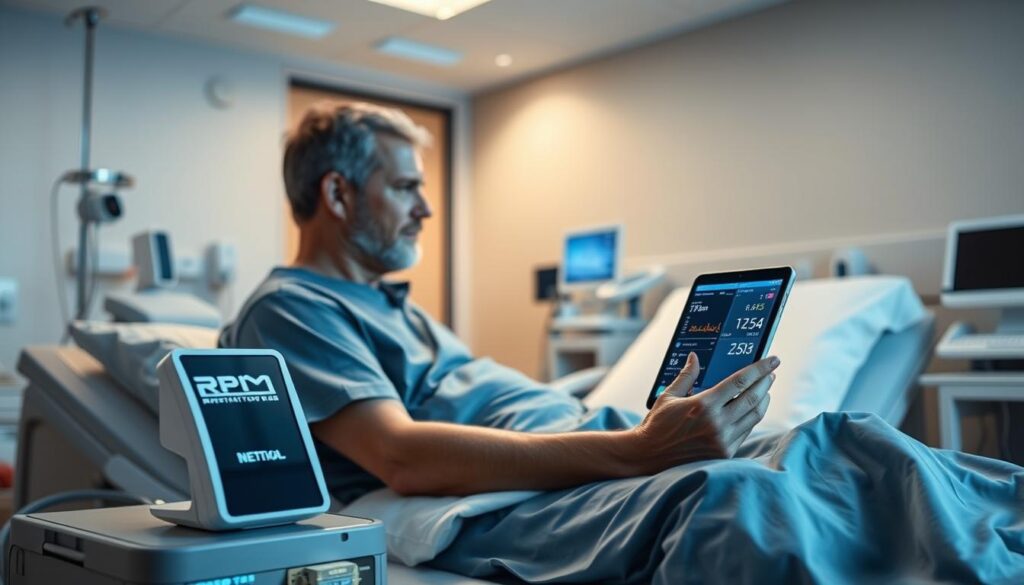
“Reimbursement momentum and executive sponsorship are turning pilots into enterprise programs that improve outcomes while easing hospital congestion.”
How organizations turn market signals into programs
- Match device options—from BYOD to clinical-grade—to risk and budget.
- Define clinical pathways and escalation playbooks to avoid alert fatigue.
- Use standardized capture and automated thresholds for earlier intervention.
| Driver | Impact | Action for Providers |
|---|---|---|
| Market & Payer Support | Long-term funding pathways | Design scalable programs that meet documentation rules |
| Staffing Constraints | Need for task routing and prioritized alerts | Adopt systems that offload manual follow-up |
| Readmission Pressure | Focus on early detection of decline | Monitor trends like blood pressure and weight; tie to escalation |
Iottive’s IoT & AIoT expertise and BLE app development help link sensors, apps, and cloud so care teams get reliable data flows during tight staffing. Linking market signals with internal goals lets organizations build programs that improve outcomes without overburdening staff.
What Remote Patient Monitoring Is and How It Helps
Connected home monitoring turns single readings into a continuous health story. Remote patient monitoring uses connected tools to capture vital signs and symptoms at home and send them to clinician dashboards. This steady stream of data helps care teams spot trends fast.
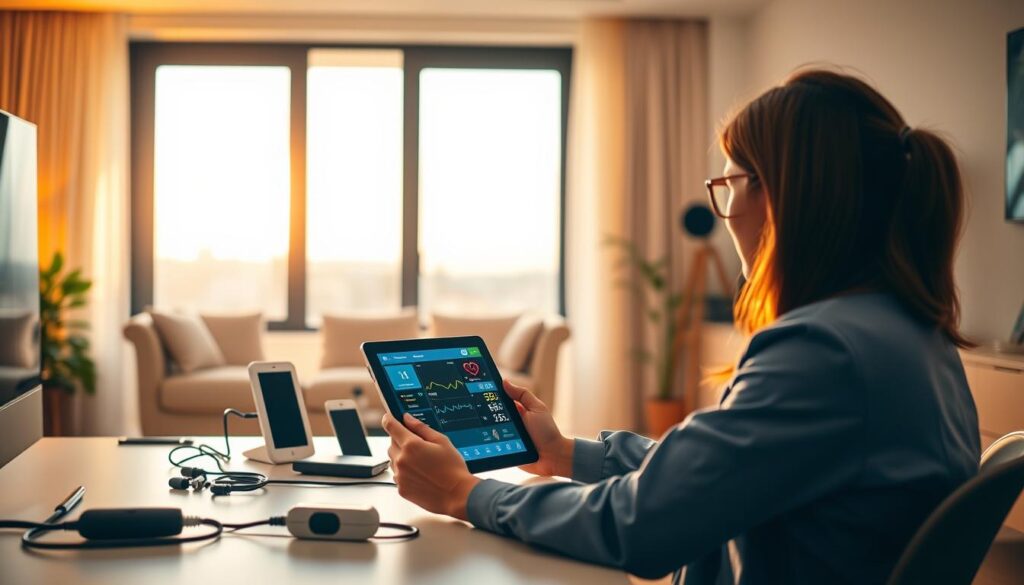
For patients
Patients gain confidence and convenience. Fewer in-person visits and earlier detection reduce emergency trips. Seeing one’s own trends improves patient engagement and treatment adherence.
For providers
Live data supports medication titration, therapy changes, and quicker triage when thresholds are crossed. Structured updates let clinicians tailor care plans on evidence, not guesswork.
For organizations
Programs cut readmissions and operating costs through centralized alerting and standardized workflows. Scaling monitoring across populations becomes practical with clear protocols.
“Real-time, structured data turns episodic snapshots into actionable narratives for better outcomes.”
- Definition: Connected tools capture vital signs and send secure feeds to dashboards.
- Patient wins: Peace of mind, earlier detection, fewer ER visits.
- Provider wins: Faster triage and tailored management.
- Org wins: Lower costs, scalable workflows, stronger engagement.
| Benefit | What It Means | How to Measure |
|---|---|---|
| Fewer ER visits | Early intervention from trend alerts | ER visit rate per 1,000 patients |
| Better adherence | Patients follow treatment with visible trends | Medication refill and engagement metrics |
| Operational efficiency | Standard alerts route tasks to the right team | Staff time per escalated alert |
Iottive integrates BLE devices and mobile apps to deliver seamless patient experiences and unified dashboards for clinicians. A well-designed program combines easy-to-use tools, clear instructions, and proactive outreach to keep momentum and prove impact over time.
chronic illness RPM devices: the core categories to know
A clear lineup of monitoring gear helps programs match measurements to specific care goals.
Blood pressure monitors track systolic and diastolic readings at home. They are central for hypertension management and for spotting trends that may signal heart failure decompensation.
Glucometers and CGMs for diabetes care
Fingerstick meters and continuous glucose monitors turn blood glucose into actionable trends. These tools help patients and clinicians adjust diet, insulin, and medications with timely data.
Pulse oximeters
Pulse ox measures SpO2 and heart rate. It is vital for COPD, asthma, and post-COVID recovery to detect drops that need prompt support.
Smart scales
Daily weights reveal fluid retention or loss. For heart and renal patients, small weight shifts can trigger medication or clinic outreach.
Wearables
Activity trackers log steps, sleep, and heart rate variability. That context helps teams understand lifestyle, recovery, and adherence between visits.
ECG/EKG monitors
Portable rhythm monitors capture arrhythmias and AFib episodes. They support post-MI follow-up and stroke-risk reduction programs.
Smart thermometers
Early fever detection aids oncology, post-op, and elderly care by flagging infection before it escalates.
Multi-parameter kits
Bundles that combine BP, pulse ox, scale, and temp simplify logistics and feed unified systems for hospital-at-home care. Studies show such kits cut admissions and mortality in post-acute programs.
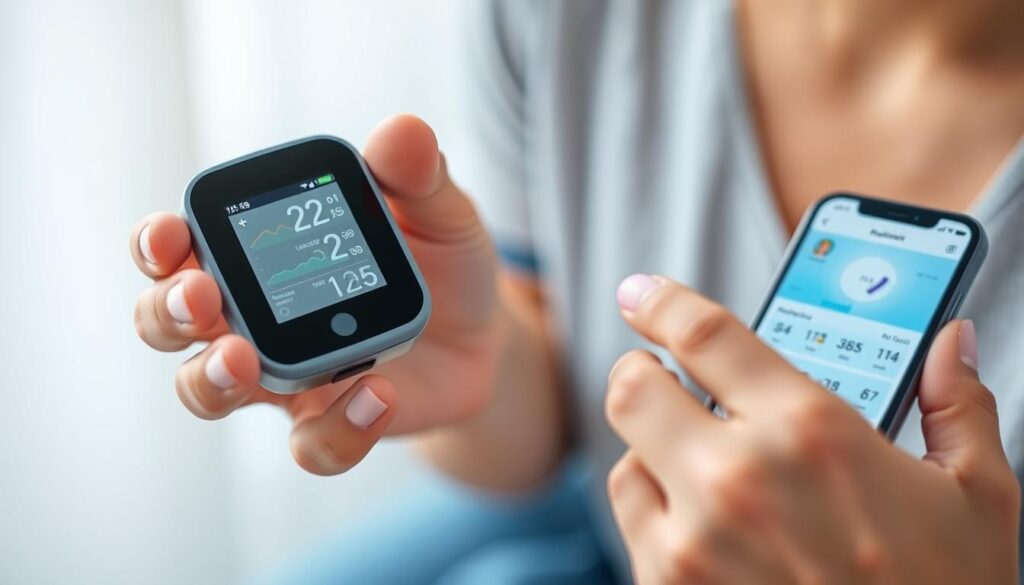
“Scotland’s home BP program reduced roughly 400,000 GP visits and saved more than £15M.”
Choosing tech that integrates matters. Iottive’s BLE and IoT expertise helps pair clinical-grade and consumer tools to ensure reliable connectivity and unified data streams so monitoring becomes actionable, not siloed.
Best-Fit Devices by Chronic Condition
Picking the right toolset matters most when programs aim for timely intervention and simpler workflows.
Iottive can integrate CGMs, connected blood pressure cuffs, spirometers, and smart scales into a single app. That unified view pairs live measurements with education and adherence nudges. Providers see trends faster and patients get clear guidance.

Diabetes
Continuous glucose monitors provide real-time blood glucose tracking and alerts. When combined with contextual education loops and messaging, they help reduce dangerous highs and lows.
Hypertension
Connected BP cuffs that capture morning and evening readings support trend-based alerts. Threshold rules and analytics guide medication changes and follow-up.
COPD and respiratory disease
Pulse oximetry plus spirometry tracks oxygen levels and lung function. Pair these with adherence checks for inhalers to spot early exacerbations.
Heart failure
Daily weight, blood pressure, and symptom surveys reveal fluid shifts and rising risk. Correlating weight with BP and symptoms enables rapid outreach before hospitalization.
“Map condition to the simplest stack that answers a clinical question — then add coaching and escalation.”
- Map stacks: CGMs + education for diabetes; BP cuffs + analytics for hypertension; SpO₂ + spirometry for COPD; scales + BP for heart failure.
- Close the loop: Combine device data with behavior coaching and medication reminders to boost adherence.
- Escalation tiers: Align threshold alerts to telehealth check-ins or urgent outreach and document readings for longitudinal care.
Real-World Impact: Outcomes Seen With RPM
Practical implementations of remote monitoring are shrinking the time between symptom onset and clinical action. That faster window drives clear benefits for patients, providers, and organizations.
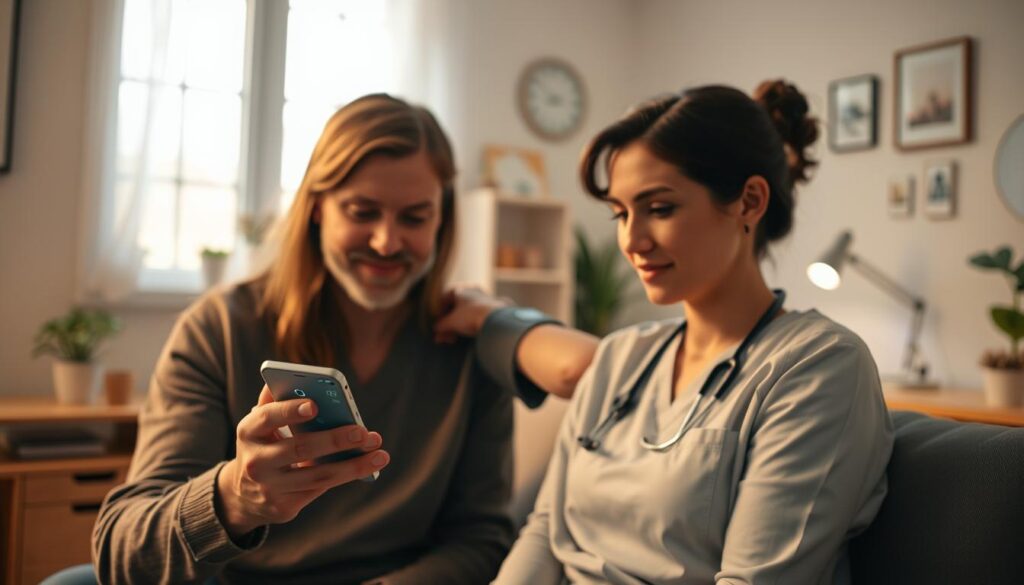
Fewer ER visits, shorter stays, and lower readmissions
Continuous monitoring closes the gap from first warning sign to clinician response. That translates into fewer ER visits and shorter hospital stays.
Studies show multi-parameter kits in post-acute programs cut admissions by 87% and mortality by 77% in high-risk cohorts. Those results free up beds and reduce family stress.
Early detection enables faster medication titration
When providers get timely home data, they adjust dosages sooner. Faster titration reduces adverse events and speeds recovery.
Iottive’s unified dashboards and alerting let care teams act quickly, turning raw readings into clear, documented steps.
Population health: outbreak tracking and risk stratification
Aggregated temperature and respiratory measures help public health teams spot outbreaks earlier.
Risk stratification focuses limited resources on patients who need attention now while reassuring those with stable readings.
“Faster intervention windows improve experience and outcomes for patients and families.”
- Continuous monitoring shortens response time and cuts avoidable visits.
- Real-world signals enable faster medication changes and tailored follow-up.
- Population-level data aids outbreak detection and targeted outreach.
- Operational wins—fewer escalations and better use of time—support clinical gains.
Track outcomes and process metrics to tune thresholds and workflows over time. Clear goals and transparent communication keep patients engaged and help programs sustain funding and partnerships.
Integration Essentials: From Device to EHR and Care Team Dashboards
A reliable pipeline from home measurement to the clinician view is the backbone of any successful monitoring program.
Cloud and mobile data pipelines must ingest readings securely, normalize them, and render near real-time insights in clinician dashboards. Architect with edge buffering, retry logic, and encrypted transport so brief outages don’t create gaps.
Cloud and mobile data pipelines for real-time visibility
Use lightweight mobile apps for BLE pairing and secure upload. Send compressed, timestamped payloads to cloud queues that feed analytics and alert engines.
Ensure the pipeline supports offline caching and device health checks so clinicians see accurate, timely views.
BYOD vs. clinical-grade devices: when each approach fits
BYOD (smartwatches, phones) boosts adoption and lowers friction for low-risk monitoring. Clinical-grade tools suit regulated metrics where accuracy and FDA rules matter.
Match choice to the clinical question: convenience for engagement; regulated tools for decisions that affect therapy or billing.
Interoperability standards and unified data views
Push normalized measurements into electronic health records using FHIR and secure APIs. Include metadata—timestamps, device IDs, firmware version, and patient context—to aid traceability.
Build role-based dashboards so clinicians, case managers, and admins see focused views with fewer false alarms.
“Command centers centralize monitoring, triage alerts, and route tasks to the right provider quickly.”
- Onboarding flows should auto-provision devices, test connectivity, and confirm patient pairing.
- Alert normalization and suppression reduce fatigue and highlight high-risk signals.
- Iterative integration testing with live cohorts validates reliability before scale-up.
| Layer | Key Feature | Why it Matters |
|---|---|---|
| Edge / Mobile | BLE pairing, offline cache | Stable uploads from home networks |
| Cloud | Queueing, analytics, retries | Near real-time insights and resilience |
| Integration | FHIR APIs, EHR sync | Continuity in electronic health records |
| Ops | Command center, role views | Rapid triage and workload routing |
Iottive delivers BLE app development, smart device integration, and cloud-to-EHR work that creates unified dashboards and reliable data pipelines. That foundation helps providers focus on care, not connectivity.
Security, Privacy, and Compliance for Remote Care Programs
Security must be as seamless as the monitoring itself so care flows without friction or risk. For remote patient monitoring to work, systems must protect patient data while staying usable for providers and patients.
Protecting PHI: HIPAA, access control, and safe harbor
Encryption in transit and at rest, least-privilege access, and immutable audit trails are baseline requirements. Implement role-based permissions, consent tracking, and clear patient notices to build trust.
FDA and clinical-grade wearables
As wearables move toward therapeutic use, follow labeling rules and post-market surveillance. Track firmware, maintain a living risk register, and review regulatory guidance frequently.
“Align security with usability so safeguards do not block timely care.”
- Adopt patching cadence, SBOM tracking, and incident response plans.
- Require vendor due diligence for cloud platforms and third-party SDKs that touch PHI or telemetry.
- Run penetration tests, mobile app hardening, BLE pairing protections, and secure boot at the edge.
- Keep logs, reports, and FHIR-based exchanges to satisfy audits and preserve interoperable data flows.
Iottive builds HIPAA-aligned solutions with access control, auditability, and regulatory awareness across IoT/AIoT stacks to help organizations scale secure, standards-based care programs.
Reimbursement and Program Design in the U.S.
Recent billing shifts mean more providers can build sustainable remote patient monitoring workflows.
CMS growth and coding basics
CMS reimbursements climbed from $5.5M in 2019 to over $101M in 2021. That surge makes remote patient monitoring a viable revenue stream for many providers and hospitals.
Billing note: patients generally must record measurements at least 16 days per month to meet common billing thresholds. Accurate device attribution and identity matching are essential for claims.
Medicaid variability and state rules
By March 2023, 34 state Medicaid programs covered monitoring, often with limits on conditions, provider type, or eligible systems.
Check state rules early when designing eligibility and enrollment workflows.
Program design to meet documentation and time thresholds
Documentation should show clinical indication, signed consent, device education, and logged interactions that reflect billed time.
- Automate time tracking and intervention logs so clinicians avoid manual entry.
- Produce audit-ready reports tying data to outreach and orders.
- Set realistic panel sizes and manage alert loads for sustainable scale.
“Design payer-ready workflows from day one to reduce rework and protect revenue.”
| Challenge | What to track | Recommended action |
|---|---|---|
| Billing thresholds | Days with measurements; time spent | Automated logs + patient reminders |
| Audit readiness | Consent, device attribution, encounter notes | Structured templates and exportable reports |
| State variability | Covered conditions & provider types | Configurable eligibility rules per state |
Iottive’s platforms support documentation, time tracking, and reporting so healthcare organizations can meet CMS and payer rules while focusing on care and outcomes.
How Care Teams Use RPM Day to Day
Care teams turn routine home readings into fast, actionable steps. Daily uploads help clinicians spot trends and act before a small change becomes a crisis.
Post-discharge cardiac rehab with multi-device kits
Example: Patients use a BP cuff, ECG patch, and smart scale each morning. Readings stream to a central dashboard that flags fluid shifts or rhythm changes.
When a weight rise or arrhythmia appears, the system alerts the right nurse or cardiologist for telehealth or in-person follow-up. This approach reduces readmissions and speeds recovery.
Diabetes management in rural settings
Connected glucose data from home meters lets providers intervene quickly. Outreach triggers when trends destabilize, pairing coaching with medication adjustments.
For rural patients, mobile networks and BLE pairing bridge access gaps so care occurs without extra travel.
Mayo-style command centers and clinician workflows
Centralized hubs route incoming ECG and vitals so the right clinician sees the right signal at the right time. Role-based alerts, batch reviews of stable patients, and threshold automations cut wasted time.
Standardized escalation rules define when to call, schedule a televisit, or send a clinician in person.
| Use Case | Key Inputs | Primary Action | Typical Outcome |
|---|---|---|---|
| Cardiac rehab | BP, ECG, weight | Flag fluid/rhythm; clinician outreach | Fewer readmissions; better heart rate control |
| Diabetes (rural) | Connected glucose, logs | Trend outreach; education loops | Faster intervention; improved self-management |
| Command center | Multi-stream vitals, alerts | Route to specialist; triage | Quicker response; lower avoidable visits |
“Central dashboards and standardized playbooks let teams act fast without chasing raw data.”
Iottive supports multi-device kits, BLE connectivity, and unified dashboards that streamline alerting and escalation for care teams.
Partnering with Iottive to Build Secure, Scalable RPM Solutions
Iottive partners with providers to turn connected hardware into trusted care pathways.
IoT & AIoT expertise: Iottive delivers BLE app development and smart device integration that ensure dependable pairing and steady telemetry. Firmware, pairing logic, and mobile UX are engineered to reduce dropouts and keep patient data flowing.
Cloud & mobile integration: Built patterns normalize and queue incoming data so clinician dashboards render near real-time trends. Integrations push structured feeds into electronic health records and role‑based views so care teams see what matters fast.
Custom product engineering
Iottive designs clinical-grade products from firmware through cloud analytics. That includes secure boot, over‑the‑air updates, and validation to meet healthcare requirements.
End-to-end platform features
- Device onboarding, identity matching, and provisioning.
- Data pipelines, alerting, and audit trails for compliance.
- Role-based access and clinician workflows tied to escalation rules.
“Our focus is aligning technical choices with clinical goals and payer rules so organizations get reliable outcomes, fast.”
Cross‑industry experience brings lessons from consumer electronics and industrial IoT into health implementations. That improves reliability, supply logistics, and usability for patients and providers.
| Capability | What Iottive Delivers | Benefit for Organizations |
|---|---|---|
| BLE & App | Robust pairing, low-energy telemetry | Fewer connection failures; steady patient uploads |
| Cloud & EHR | FHIR-ready APIs, normalized data | Continuity in electronic health records; easier claims support |
| Security | Encryption, audit trails, access controls | Lower compliance risk; protected PHI |
| Product Engineering | Firmware, UX, validation | Clinical-grade outcomes; faster time to value |
Testing and rollout: Iottive supports iterative pilots, validation testing, and phased deployments to minimize disruption and accelerate scale. Teams get training, support, and configurable workflows tailored to patient populations and service lines.
Invite collaboration: Work with Iottive to select the right device mix, build secure systems, and deliver monitoring that helps patients and care teams, while meeting payer and regulatory expectations.
How to Choose the Right RPM Devices and Platform
Start by defining the clinical question your monitoring program must answer and map that to measurable metrics. Clear goals make technology choices simpler and keep care focused on outcomes.
Define clinical goals, target metrics, and alert thresholds
Match metrics to condition and care plans. For example, map blood pressure, SpO₂, weight, or glucose to specific thresholds that trigger outreach.
Set escalation tiers so alerts align with staffing and expected response time.
Evaluate interoperability, usability, and patient training needs
Pick systems that integrate with electronic health records and provider workflows to avoid fragmented data. Prioritize simple setup, clear instructions, and upfront training so patients capture accurate readings consistently.
Assess data security, auditability, and regulatory pathways
Require end-to-end encryption, access controls, and immutable logs for auditability. Confirm regulatory status for clinical-grade hardware and track firmware and metadata for traceability of remote patient streams.
Plan for scalability, logistics, and support across care teams
Decide between BYOD for convenience or clinical-grade gear for accuracy, or use a hybrid approach. Plan kitting, shipping, replacements, and a support workflow so monitoring devices stay in service.
- Validate with pilots, refine thresholds, and measure outcomes.
- Align alerting with staffing to avoid fatigue and meet SLAs.
- Partner with experienced builders—like Iottive—to integrate with EHRs, secure data, and scale logistics.
| Decision | Key Question | Action |
|---|---|---|
| Metric selection | What answers the clinical question? | Map to target thresholds and schedules |
| Integration | Will this feed electronic health records? | Test FHIR APIs and workflow handoffs |
| Support | How will patients get help? | Design training, helpdesk, and swap logistics |
“Start with the clinical question, not the gadget, and build policies that keep care timely and measurable.”
Conclusion
Modern patient monitoring links everyday measurements to faster, smarter clinical choices. When remote patient monitoring and a clear workflow join, routine readings become timely care signals that help providers and patients avoid needless visits.
Map the right patient monitoring devices to each condition, build interoperable systems, and lock in security and privacy. Iottive supports BLE pairing, cloud & mobile integration, and custom IoT platforms so data flows reliably into clinician views.
Measure impact—readmissions, visits avoided, engagement—and train teams to keep adherence high. Design documentation, time thresholds, and smart alerting to protect reimbursement and scale operations.
With multidisciplinary teams and command‑center workflows, organizations can expand precision, personalization, and access in chronic disease care. Translate these insights into a practical roadmap and move care forward with confidence.
FAQ
What is remote patient monitoring and how does it help people with long-term conditions?
Remote patient monitoring uses connected health tools — such as blood pressure cuffs, glucometers, pulse oximeters, and wearable heart-rate trackers — to collect vital signs and transmit them to care teams. This gives patients more confidence, reduces in-person visits, and supports better self-management. Providers gain near real-time data for faster triage and personalized care plans, while health systems see improved outcomes and lower readmission risk.
Which types of monitoring tools are most commonly used for managing hypertension and heart disease?
Connected blood pressure monitors, smart scales, and ECG/EKG patches are primary tools for hypertension and heart failure management. These tools track trends in blood pressure, weight (for fluid retention), and rhythm abnormalities to guide medication titration and timely interventions by clinicians and care teams.
How does continuous glucose monitoring compare to traditional glucometers for diabetes care?
Continuous glucose monitoring (CGM) provides ongoing glucose trends and alerts for highs and lows, enabling proactive dosing and lifestyle adjustments. Traditional glucometers give point-in-time readings. CGMs paired with education loops and clinician review often yield better glycemic control and higher patient engagement, especially in remote or rural settings.
Are pulse oximeters and spirometers useful for respiratory conditions and post-COVID care?
Yes. Pulse oximeters provide SpO₂ and heart rate readings for COPD, asthma, and post-COVID monitoring. Spirometry and adherence-tracking inhaler sensors help assess lung function and medication use. Together, they support early detection of deterioration and reduce emergency visits.
How do wearable devices contribute to remote monitoring programs?
Wearables track activity, sleep, and heart rate variability, offering continuous physiological context that complements spot measurements. They help clinicians identify trends, adjust care plans, and motivate patients through engagement features. For clinical-grade needs, validated wearables or multi-parameter kits are preferred.
What does integration with electronic health records (EHR) involve?
Integration requires secure cloud and mobile data pipelines that feed device readings into EHRs and care dashboards. Interoperability standards and APIs enable unified views so clinicians can see device trends alongside clinical notes, supporting faster decisions and coordinated care across teams and organizations.
How do providers balance BYOD (bring your own device) versus clinical-grade equipment?
BYOD can increase access and lower costs for routine monitoring, but clinical-grade devices offer validated accuracy and regulatory oversight for higher-risk patients. Choose BYOD for engagement and low-acuity cases; choose regulated devices for medication changes, hospital-at-home, or billing requirements.
What security and privacy safeguards are required for remote monitoring data?
Protecting patient health information means HIPAA-compliant platforms, strong access controls, encryption in transit and at rest, and audit logs. For regulated devices, manufacturers and providers must also follow FDA guidance and maintain clear data governance across cloud services and mobile apps.
How does reimbursement work for remote monitoring in the United States?
Medicare and many private payers reimburse monitoring under specific CPT codes that reflect time and engagement thresholds. Medicaid coverage varies by state. Successful programs design workflows that document clinical time, device data review, and patient contacts to meet billing requirements.
What outcomes can health systems expect after deploying remote monitoring programs?
Programs commonly report fewer ER visits, shorter hospital stays, and reduced readmissions. Early detection from continuous data enables quicker medication titration and targeted interventions, improving population health metrics and lowering total cost of care.
How do care teams use monitoring data day to day?
Clinicians and nurses review dashboards for alerts and trends, prioritize outreach for at-risk patients, and adjust care plans. Examples include post-discharge cardiac rehab with multi-parameter kits, diabetes management using connected glucose data, and centralized command centers that route escalations to clinicians.
What should organizations evaluate when choosing a monitoring platform?
Define clinical goals, target metrics, and alert thresholds first. Then assess interoperability with EHRs, usability for patients, patient engagement tools, logistics for device distribution, data security, and scalability. Consider vendor experience with cloud integration, BLE app development, and regulatory pathways.
Can remote monitoring be scaled across large patient populations?
Yes. Scalable programs combine automated data ingestion, configurable alert rules, centralized dashboards, and standardized protocols for escalation. Cloud platforms and unified views help population health teams stratify risk and deploy resources efficiently across providers and care settings.
What role do IoT and AI technologies play in modern remote care?
IoT connects medical hardware to apps and cloud services; AI and analytics surface patterns, predict deterioration, and reduce alert fatigue. These technologies power smart device integration, improve triage accuracy, and support personalized interventions across healthcare organizations.
Transform Your IoT Vision Into Reality.
Get free expert insights, architectures & cost breakdowns.
Drop your email to schedule free meeting.